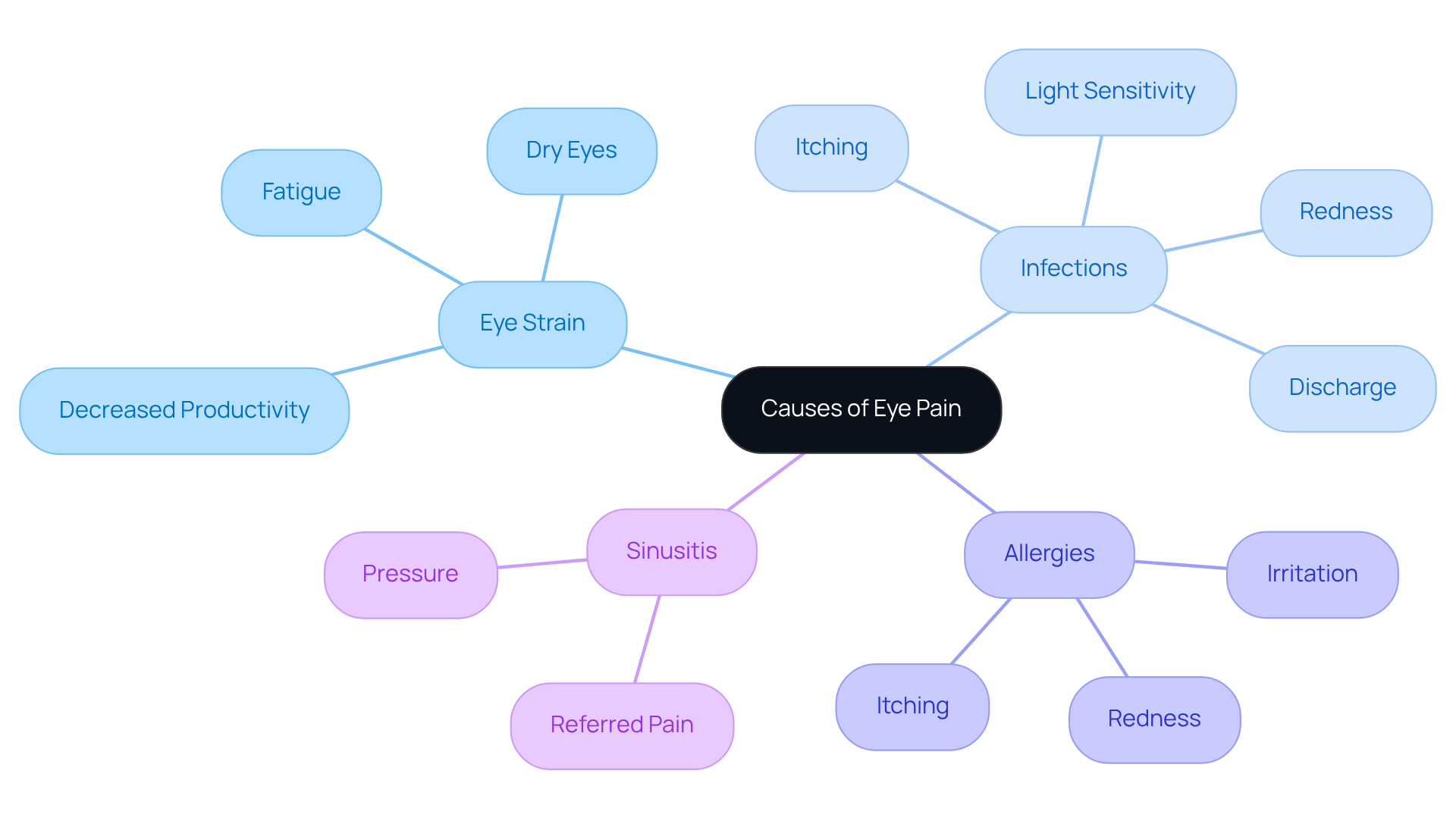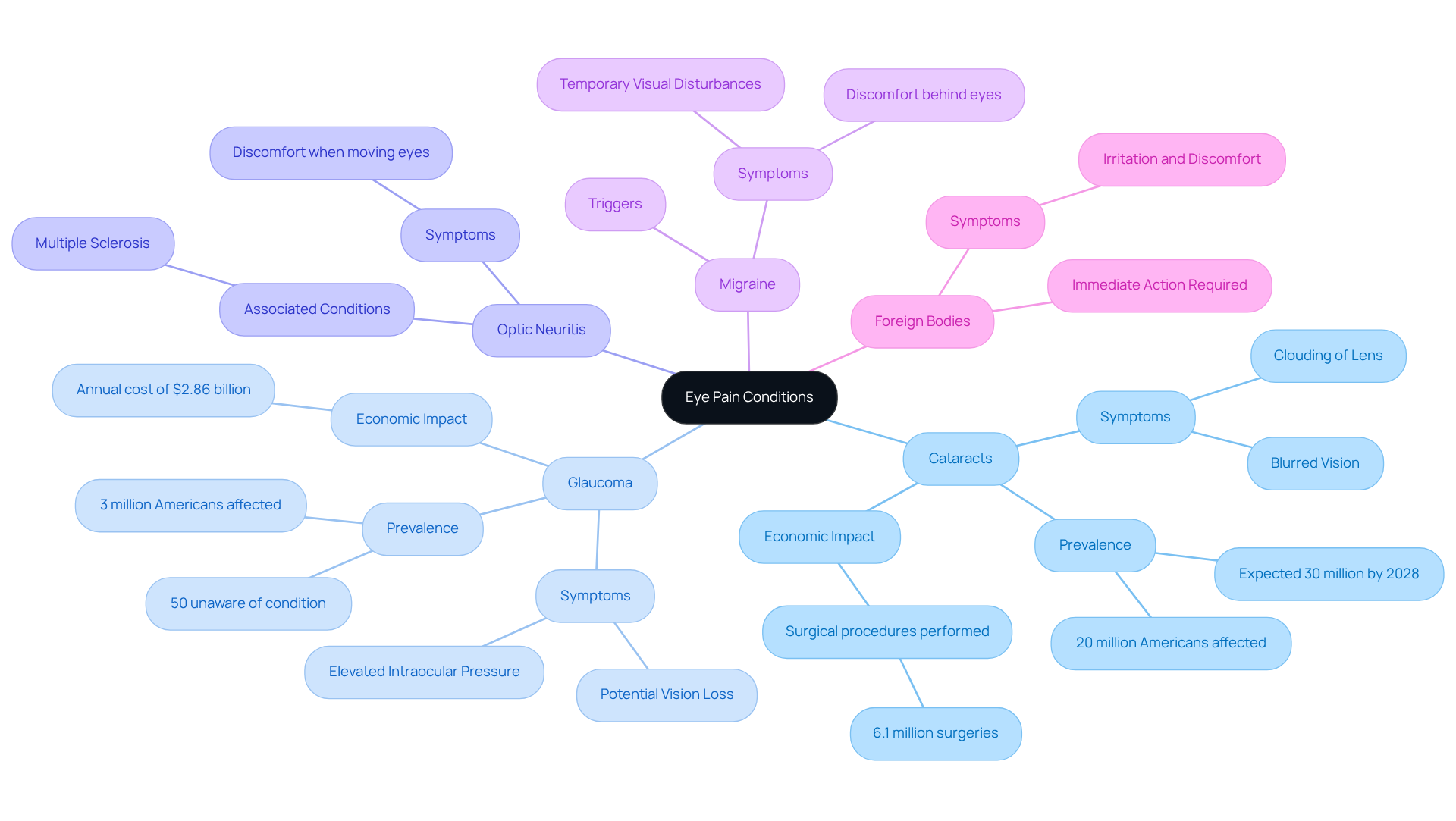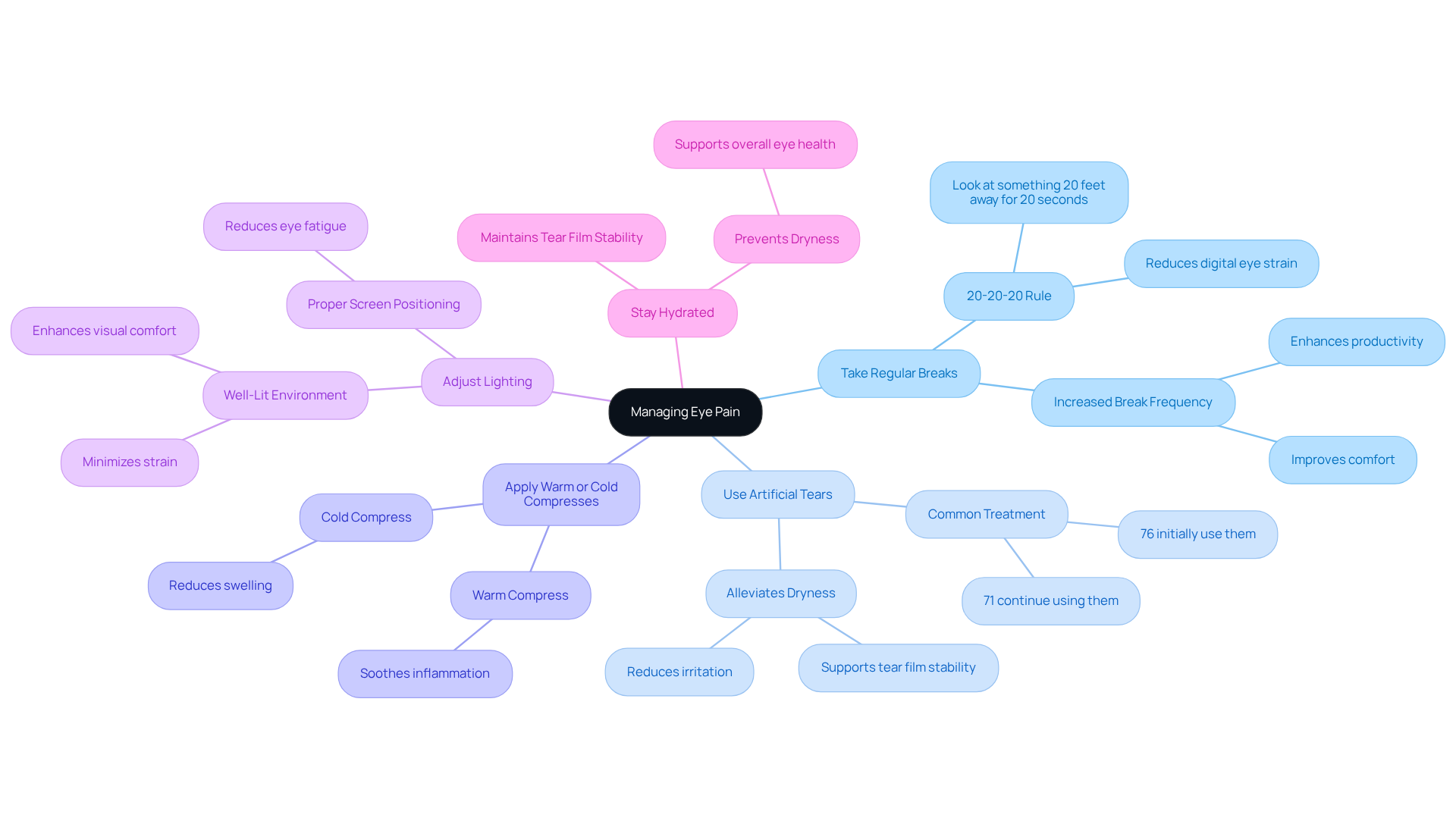Posted by: Northwest Eye in General on October 10, 2025
Overview
Experiencing eye pain when moving your eyes can be concerning, and it’s important to understand that various factors may contribute to this discomfort. Common causes include:
- Eye strain
- Infections
- Allergies
- Sinusitis
- Underlying conditions like cataracts or glaucoma
We understand that these possibilities can be overwhelming, but knowing the causes can help you address your concerns.
To alleviate discomfort and improve your overall eye health, there are effective management strategies you can try:
- Taking regular breaks during activities that require intense focus
- Using artificial tears to keep your eyes lubricated
- Ensuring proper lighting in your environment
These practices can make a significant difference. Remember, you are not alone in this journey; many have found relief through these simple yet effective practices.
We are here to help you through this process and encourage you to seek care if your symptoms persist. Your comfort and well-being are our priorities, and we want to support you in finding the right solutions for your eye health.
Introduction
Experiencing eye discomfort can be both perplexing and distressing. We understand that sometimes, even the simple act of moving your eyes can intensify the pain. This sensation can arise from various underlying issues, ranging from everyday habits like excessive screen time to more serious conditions such as glaucoma and optic neuritis. It’s essential to understand the causes and symptoms of eye pain, especially if you’re seeking relief and improved vision health.
What if this discomfort is signaling a deeper problem? It’s common to feel anxious about these sensations, but knowing how to effectively manage them can significantly enhance your quality of life. We are here to help you through this process.
Explore the Basics of Eye Pain: Causes and Symptoms
Eye discomfort can manifest in various forms, including sharp, dull, throbbing, or burning sensations, each indicating different underlying issues. We understand that experiencing any form of eye pain can be concerning. Common causes of eye pain include:
- Eye Strain: Often resulting from prolonged screen time or reading without breaks, eye strain affects a significant portion of the population. It’s common to feel fatigued, with estimates suggesting that 50% to 90% of screen users experience symptoms of Digital Eye Strain (DES). This discomfort, especially when my eyes hurt when I move them, can lead to fatigue and a decrease in overall productivity, making it vital to take regular breaks. When I have due to insufficient tear production, my eyes hurt when I move them, creating a gritty sensation. We want you to know that effective treatments for dry eye, such as artificial tears and lifestyle modifications, have shown promising results in alleviating symptoms and improving quality of life.
- Infections: Conditions like conjunctivitis and keratitis can lead to significant pain and redness. It’s important to seek prompt medical intervention to prevent complications. Symptoms of conjunctivitis can include redness, itching, and discharge, whereas keratitis may lead to blurry or double vision and light sensitivity.
- Allergies: Allergic responses can lead to irritation, redness, and itching in the eyes, often worsened by environmental elements. This discomfort may necessitate specific therapies to relieve symptoms, and we encourage you to discuss these options with your healthcare provider.
- Sinusitis: Characterized by inflammation of the sinuses, sinusitis can lead to referred pain, making it feel like my eyes hurt when I move them, especially during movement. This highlights the interconnectedness of ocular and sinus health, and we understand how challenging this can be.
Identifying these indicators early is essential for pursuing prompt medical assistance. We are here to help you through this process, as timely care can avert additional complications and improve overall eye health. As the prevalence of eye strain continues to rise, understanding these common signs and their implications becomes increasingly important for effective management, particularly for cataract patients who may face additional challenges related to their condition.

Identify Common Conditions Associated with Eye Pain
Eye discomfort, such as the feeling that my eyes hurt when I move them, can arise from various conditions, each presenting unique symptoms and implications for your vision health. We understand that experiencing these symptoms can be concerning, and it’s important to be informed about what you might be facing. Here are some key conditions to consider:
- Cataracts: This condition involves the clouding of the lens, leading to discomfort and blurred vision. With more than 20 million Americans impacted, are a common factor in visual impairment, especially in individuals over 40. By 2028, it is expected that over 30 million people will have cataracts, highlighting the growing issue.
- Glaucoma: Characterized by elevated intraocular pressure, glaucoma can lead to intense discomfort and potential vision loss if left untreated. Approximately 3 million Americans live with glaucoma, with open-angle glaucoma affecting about 95% of individuals. Early detection is crucial, as many individuals may be unaware of their condition. The economic burden of glaucoma is significant, estimated at $2.86 billion annually.
- Optic Neuritis: This inflammation of the optic nerve often results in discomfort, leading to the sensation that my eyes hurt when I move them, and is frequently associated with multiple sclerosis. Understanding this condition is vital, as it can significantly impact your vision and quality of life.
- Migraine: Ocular migraines can result in temporary visual disturbances and discomfort behind the eyes, impacting daily activities. These migraines are frequently accompanied by additional signs, making it crucial for you to identify your triggers.
- Foreign Bodies: The presence of any object in the eye can cause considerable discomfort and irritation, necessitating immediate medical attention to prevent further complications.
Identifying these conditions is crucial for you to comprehend the severity of your signs and the significance of pursuing professional assessment. Regular eye exams are essential for early detection and management of these conditions. We encourage you to seek care, as early intervention can prevent serious complications and improve your overall eye health.

Implement Effective Strategies for Managing Eye Pain
To effectively manage eye pain, we understand that you may be seeking relief and comfort for when your eyes hurt when you move them. Consider implementing the following strategies:
- Take Regular Breaks: We encourage you to adhere to the 20-20-20 rule—every 20 minutes, shift your gaze to something 20 feet away for at least 20 seconds. This simple practice can significantly alleviate , particularly when I notice that my eyes hurt when I move them, and improve your comfort. As noted by Srirat Lormphongs, “This study demonstrates the effectiveness of the 20-20-20 rule in reducing digital eye strain.”
- Use Artificial Tears: If you’re experiencing dryness and irritation, over-the-counter lubricating eye drops can be a common and effective solution. Studies indicate that 76% of individuals with dry eye initially use artificial tears, and 71% continue to use them, highlighting their importance in managing symptoms.
- Apply Warm or Cold Compresses: Depending on the underlying cause of your pain, a warm compress can help soothe inflammation, while a cold compress may reduce swelling and discomfort.
- Adjust Lighting: It’s common to feel strain from poor lighting, which can make my eyes hurt when I move them. Ensure that your reading or screen environment is well-lit to minimize strain. Proper lighting can significantly enhance your visual comfort and prevent situations where your eyes hurt when you move them, thereby reducing the risk of eye fatigue.
- Stay Hydrated: Maintaining hydration is essential for your overall eye health. Drinking plenty of water helps prevent dryness and supports the tear film’s stability, which is crucial for your eye comfort.
By incorporating these strategies into your daily routine, you can effectively reduce discomfort and enhance your overall eye health. Additionally, being aware of gender differences in digital eye strain prevalence can inform personalized approaches to your eye care. Remember, we are here to help you through this process.

Conclusion
Experiencing discomfort in the eyes, particularly when moving them, can be a distressing issue that affects daily life. We understand that this pain can be concerning, and recognizing the various causes and conditions associated with it is crucial for effectively addressing the problem. From eye strain and infections to allergies and more serious conditions like glaucoma and cataracts, acknowledging the symptoms and seeking timely medical intervention can significantly improve your eye health and overall well-being.
This article delves into the common causes of eye pain, emphasizing the importance of identifying symptoms early for better management. We highlight practical strategies for alleviating discomfort, such as:
- Adhering to the 20-20-20 rule
- Using artificial tears
- Making necessary adjustments to lighting and hydration
Each of these approaches can contribute to reducing eye strain and enhancing comfort, especially for those who spend extended periods in front of screens.
Ultimately, prioritizing your eye health is essential in today’s visually demanding world. By taking proactive steps to manage eye discomfort and seeking professional help when necessary, you can safeguard your vision and improve your quality of life. Embracing these practices not only enhances eye comfort but also fosters a deeper understanding of the interconnectedness of eye health and overall wellness. Remember, we are here to help you through this process.
Frequently Asked Questions
What are the different types of eye pain?
Eye discomfort can manifest as sharp, dull, throbbing, or burning sensations, each indicating different underlying issues.
What is a common cause of eye pain related to screen use?
Eye strain is a common cause of eye pain, often resulting from prolonged screen time or reading without breaks. It affects a significant portion of the population, with estimates suggesting that 50% to 90% of screen users experience symptoms of Digital Eye Strain (DES).
What symptoms are associated with dry eyes?
Symptoms of dry eyes include a gritty sensation and discomfort, especially when moving the eyes due to insufficient tear production.
What treatments are available for dry eye symptoms?
Effective treatments for dry eye include artificial tears and lifestyle modifications, which have shown promising results in alleviating symptoms and improving quality of life.
What infections can cause significant eye pain?
Infections such as conjunctivitis and keratitis can lead to significant pain and redness in the eyes.
What are the symptoms of conjunctivitis?
Symptoms of conjunctivitis include redness, itching, and discharge.
What symptoms are associated with keratitis?
Keratitis may cause blurry or double vision and light sensitivity.
How can allergies affect eye comfort?
Allergic responses can lead to irritation, redness, and itching in the eyes, often exacerbated by environmental elements.
What is sinusitis and how does it relate to eye pain?
Sinusitis is characterized by inflammation of the sinuses and can lead to referred pain, making it feel like the eyes hurt during movement.
Why is it important to identify eye pain indicators early?
Identifying eye pain indicators early is essential for pursuing prompt medical assistance to prevent complications and improve overall eye health.






